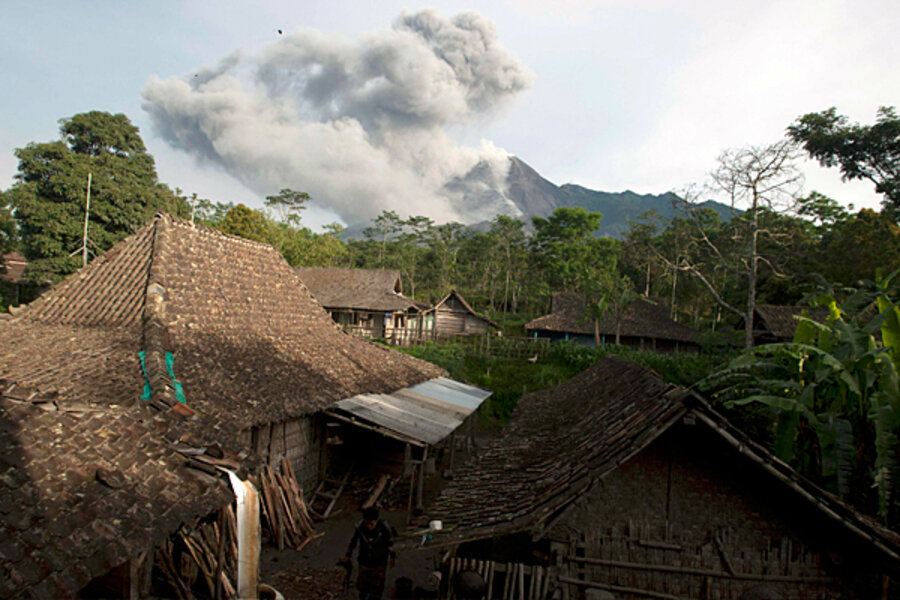Indonesia's Merapi volcano erupts again and threatens more
Loading...
| Jakarta, Indonesia
Rains dampened relief efforts around Indonesia’s Mt. Merapi, as it erupted for a third time Friday. The country’s most active volcano has been spewing hot ash and debris since Tuesday, killing at least 34 people and displacing around 50,000.
Friday morning’s blast was mostly hot clouds and smoke, but it signaled that the volcano’s wrath was not over. Surono, the head of Indonesia’s Volcanology and Geological Disaster Mitigation Agency, says a lot of the pressure inside the volcano has been relieved by the blast but there's still cause for concern.
“The energy is different. It is still three times greater than before 2006,” he says, referring to Merapi’s last eruption. Surono says he doesn't think there will be another massive explosion like the one Tuesday, but authorities are warning refugees to remain in temporary shelters.
More than 40,000 people had fled or been evacuated earlier in the week. But many stayed behind, or returned as the volcano became calmer, to care for the livestock on which their livelihoods depend.
Spiritual connection to Merapi
The 11,000 people who live on Merapi’s fertile slopes are mostly traditional farmers. Merapi means Mountain of Fire, and many have deep spiritual ties to the volcano. They believe its activity is caused by spirits, and rely on a respected elder to intercede with the spirts as the mountain’s gatekeeper. Mbah Maridjan, Merapi's longtime gatekeeper, was killed along with about 30 others in Merapis initial explosion this week. A new one will be appointed by the Sultan of Yogykarta.
“People here have their own local wisdom,” says Widi Sutikno, head of the Merapi Disaster Mitigation Command Post. The villagers' dependence on the land and their cattle also kept many from wanting to stay in the temporary shelters.
Thursday’s eruption drove those who had returned to their homes back down Merapi’s slopes, adding additional strain to already overcrowded shelters.
“There are more and more refugees coming down the mountain,” says Rukman, the head of disaster response for the Indonesian Red Cross (PMI). “We need water and better sanitation; that is the big problem.”
The PMI is working with the government to provide medical services and counseling to refugees, while international nongovernmental organization are helping distribute supplies to the four districts closest to the volcano.
“Our focus is on meeting the needs of the children,” says Yeye Edwina, a coordinator with the Christian humanitarian organization World Vision, which is distributing 2,000 relief kits containing toothpaste, toothbrushes, soap and blankets.
Rain has helped clear the air of ash, but many of those in evacuation centers have been forced to sleep on thin mats on damp ground. Relief workers say many children have coughs and they worry about respiratory problems.
Rising tsunami death toll
Meanwhile, the death toll 800 miles to the west in the tsunami-hit Mentawai Islands ratcheted up to nearly 400 Friday, with officials saying search teams were continuing to look for the hundreds still missing.
A 10-foot wave sparked by a 7.7-magnitude earthquake hit the remote Mentawai Island chain Monday evening, taking most residents by surprise. Disaster official Ade Edward says around 420 homes had been destroyed or damaged and a handful of villages flattened.
The Mentawais are comprised of four main islands, with a total population of around 40,000. Unlike earlier disasters that hit higher population centers, a death toll in the hundreds is likely to have a significant impact on the Mentawais. Officials say the lack of warning and secure shelter may be one reason the death toll has been so high.
Rescue workers say many bodies may have been swept out to sea, but some people are believed to have run inland in search of safety. Mr. Edward says he hopes people will begin returning to their villages now that the danger is over.
Thousands of volunteers and rescue officials have arrived to oversee relief efforts that include medical services and supply distribution. Officials now are focused on creating a plan to assist those in need beyond the initial search and rescue efforts.
Indonesia sits on the Pacific Ring of Fire and is prone to frequent earthquakes and volcanic eruptions. Mount Merapi killed 1,300 people in 1930, while an earthquake off the coast of north Sumatra in 2004 sparked a tsunami that killed more than 230,000 people across the Indian Ocean.





